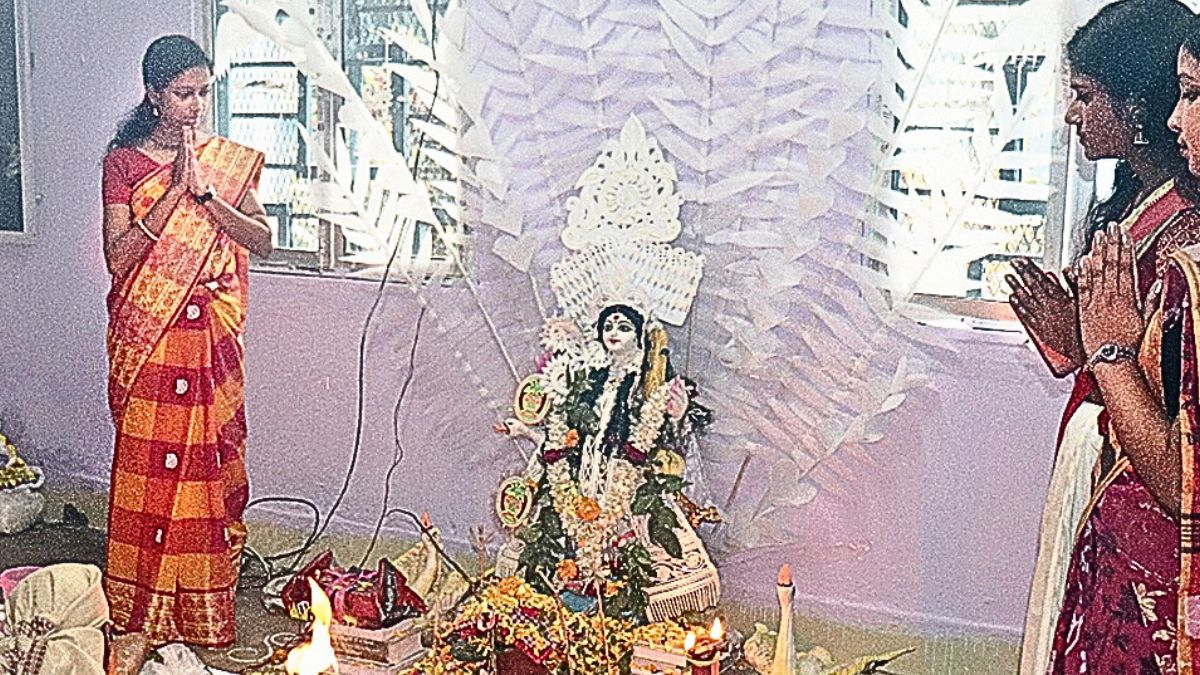
Saraswati Puja, also known as Basant Panchami, is a festival dedicated to Goddess Saraswati, the deity of wisdom, learning, music, and arts. It is one of the most widely celebrated festivals in Bengal, especially among students and educational institutions.
Saraswati Puja in 2025 will be observed on February 2 and 3, marking an auspicious day for seeking blessings for knowledge and wisdom. Goddess Saraswati symbolizes intellect, creativity, and enlightenment. She is depicted as a serene deity clad in white, seated on a lotus, and holding a veena (a musical instrument), a book, and a rosary. Her vahana (vehicle), a swan, represents wisdom and the ability to differentiate between right and wrong.
In Bengal, Saraswati Puja holds a special place in the hearts of students, artists, and scholars. It is considered the “Bengali Valentine’s Day” as young people often use this occasion to express their feelings to their loved ones.
Rituals of Saraswati Puja in Bengal
Saraswati Puja is performed with great devotion and enthusiasm in homes, schools, colleges, and community spaces. The rituals begin early in the morning and continue throughout the day.
1. Preparing the Idol and Altar
The idol of Goddess Saraswati is placed on an altar adorned with yellow and white flowers, symbolizing purity and prosperity. A chalk (alpona) design, often featuring the Veena, swan, and lotus, is drawn on the floor as a decorative element.
2. Worship Rituals (Puja Vidhi)
- Pran Pratistha: The ritual of invoking the goddess into the idol.
- Shodashopachara Puja: Sixteen steps of offering, including bathing the idol, dressing it in yellow, and presenting flowers, fruits, sweets, and incense.
- Pushpanjali (Flower Offering): Devotees, especially students, offer flowers while chanting the Saraswati Vandana and seek blessings for knowledge and wisdom.
- Aarti and Bhajans: Devotional songs and hymns praising Goddess Saraswati are sung.
3. No Studies for the Day
On Saraswati Puja, books, pens, and musical instruments are placed near the goddess’s feet for blessings. A unique tradition followed in Bengal is that students refrain from studying on this day as a mark of respect to Saraswati.
4. Cultural Programs and Celebrations
Many schools, colleges, and cultural institutions organize recitations, debates, and musical performances as part of the celebrations. Art competitions and literary discussions are also common.
5. Sindoor Khela and Visarjan (Immersion of the Idol)
In some regions, women engage in Sindoor Khela, applying vermilion on each other as a symbol of prosperity. The festival concludes with the immersion of the idol in a nearby river or pond, symbolizing the return of the goddess to her celestial abode.
Celebration of Saraswati Puja in Different Parts of Bengal
- Kolkata: The city witnesses grand celebrations with beautifully crafted idols in schools, colleges, and community spaces. Kumartuli, the famous potter’s district, is known for its exquisite Saraswati idols.
- Shantiniketan: The festival is celebrated with an artistic fervor at Visva-Bharati University. Students dressed in traditional yellow attire participate in music, dance, and poetry recitals.
- Nabadwip and Bishnupur: These regions, famous for their temples and cultural heritage, celebrate Saraswati Puja with special rituals and processions.
Traditional Food of Saraswati Puja
Food plays an essential role in the celebration. Some of the traditional dishes prepared on this day include:
- Khichuri (Lentil and rice dish): A must-have during the puja bhog.
- Labra (Mixed vegetable curry): Served with khichuri.
- Beguni (Fried brinjal slices): A crispy delight.
- Malpua and Sandesh: Offered as prasad and relished by devotees.
Saraswati Puja is more than just a religious festival in Bengal, it is a celebration of knowledge, creativity, and love. The festive spirit, traditional rituals, and vibrant gatherings make it a cherished occasion for students and families alike. As Saraswati Puja 2025 approaches, Bengalis across the world look forward to seeking the goddess’s blessings for wisdom and prosperity, while also celebrating cultural heritage with great enthusiasm.
